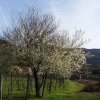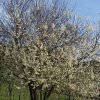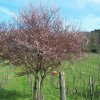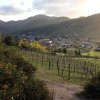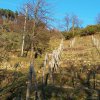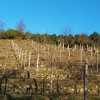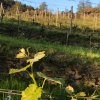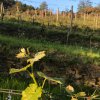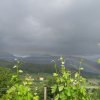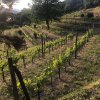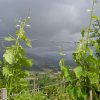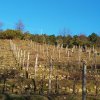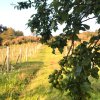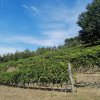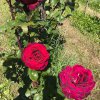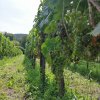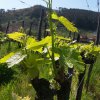Vineyards
Mother Earth Nature
Arriving in Vorno, walking to Scompiglio and seeing a vineyard, hidden for many years by brambles, acquired and transformed by the work of man like a historical find, almost an archaeological excavation. After a few years tasting the grapes, feeling their potential and, with the strength of a working group, not only manual but also intellectual, deciding to recover and expand the ampelographic base of those grapes in order to rediscover the physiognomy of a terroir. Returning the aromas and the sparkle of the wine back into the glasses, blending the tradition of that land with today’s knowledge, to bring back to life flavours, tastes and aromas that could have been lost. All this with absolute respect for what a simple branch of vine placed in this land gives us.
Claudio Gori - Oenologist
The vineyard is for us is the starting point to make a great wine, together with the soil and the environment that hosts it. Each vineyard has its own story to tell, and its own expressiveness. Our aim is to allow our wines to express their terroir with purity. We like to think of “nature - mother earth” as the place where it all began, because she gave us a gift that we took care of, without upsetting the balance and trying to grow the vines in an authentic and natural habitat to produce fruit that convey the characteristics of the land.
Thus, we are able to create a genuine, high quality and environmentally friendly product.
In fact, in our view, the terroir is not just the land, but also an ecosystem to be protected, a complex set of factors that starts from the soil and also includes environmental and chemical-physical conditions. The geographical position of the vineyards, which is quite particular, creates a system that helps to create the identity of each wine.
The terroir of this area is inimitable. The soils are very different from each other, depending on the location: the upper part, situated in the woods, has soils rich in stone and clay, while those in the lower part are sandy-loam. To the characteristics of the soil are added those of the climate; the upper part is cooler and drier, with excellent temperature variations at night, while the lower part is warmer and more humid, but with useful air currents during the hottest hours. The orientations also differ, varying from north-east, to north-west, to due west. This valuable diversity allows us to grow the same vine varieties – Syrah, Sangiovese, Canaiolo and Colorino – in different areas, obtaining differing expressions of the same vines.
As an example, our Upper Syrah, grown in the woods, has an intense ruby red colour, aromas of coffee, tobacco and the characteristic note of black pepper, with a very strong tannic structure. On the other hand, the Pure Syrah, grown on the flat part, has a bright ruby red colour, is rich in varietal fruity notes, such as cherry and blackcurrant, and has very velvety tannins.
The wine is then made in our cellar, maintaining the naturalness of the product, which is why we add few sulphites and do not use chemical additives, neither in the winemaking nor during the bottling. Ultimately, our vinification duly respects the amount of time that the vines require, waiting for the right maturation and aging times for the wine, without forcing it with invasive oenological practices.
Elena De Gioia - Vineyard and Cellar manager
Vigna Madre
Vigna Madre (Mother Vineyard)
Brought to light after years of neglect, this vineyard began to bear fruit in 2006, the same year in which began an in-depth study of the soil and of the grape varieties contained within it. The vineyard was in a good state of vegetative and phytosanitary health, despite the blanket of brambles, and there was great variability in its composition. Among the black grape varieties, the prevalent grape is the Canaiolo Nero, of which there are certainly two different biotypes in the vineyard. In addition, and just as important, are the so-called "Colorini”. In Tuscany, this name traditionally indicates those grape varieties with coloured grape pulp, or white with a very thick skin and rich in anthocyanins, which are therefore used for blending with other varieties less rich in colouring properties. We have identified two different Colorini; a traditional one named Colorino di Lucca and another that appears to be the named variety, Grand Noir. Other vines were then identified, among them Sangiovese, Ciliegiolo, Malvasia Nera, and Bonamico, all of which were present sporadically throughout, except for the Sangiovese. Considering the age of the vineyard and the fact that the plants have never been replaced, we can assume that all the plants found within are not of clonal origin, as in modern vineyards, but massale selections, that is, originating from a time when farmers and especially the grafters made their own selections from the vineyards of the area. This means that within the vineyard there is a historic heritage and viticulture that certainly must be preserved and enhanced.
The fruits of the Mother Vineyard become the wine Lavandaia, Madre.
Vigna Alta
Vigna Alta (High Vineyard)
Under a blanket of brambles, shrubs and trees, an archaeological excavation of viticulture has uncovered, almost intact, a plot in the hills formed of terraces reinforced by dry stone walls. Reclaimed and reassigned to the ancient function of vineyard, today this plot constitutes the Vigna di Monte (Mountain Vineyard). After careful analysis of the soil, its texture and its orientation, it was decided to dedicate this plot to a single variety, Syrah, which has been cultivated for centuries in Italy and the Lucca area, so much so, that it can almost be regarded as indigenous. The Vigna di Bosco (Forest Vineyard) was later added to the Vigna di Monte, and also cultivated with Syrah, which here enjoys a different orientation and is situated at an even higher altitude.
The fruits of the Mother Vineyard become the wine Lavandaia, Alta.
Vigne Basse
Vigne Basse (Lower Vineyards)
The lower vineyards, divided into plots adjacent to the Cucina Dello Scompiglio and the Vigna della Colonne, were designed to augment and complete the original idea for the Vigna Madre (Mother Vineyard), to make a true "phenological garden", in which to grow a collection of the principle varieties native of the area. For this reason it was decided to plant the same varieties in this vineyard as in the Vigna Madre, derived from those same plants by means of particular techniques of selection and propagation; so in the future there will be Syrah, Sangiovese, Colorino and Canaiolo.
The fruits of the Mother Vineyard become the wines Lavandaia, Nuova, Lavandaia, Pura, Lavandaia, Bassa, Lavandaia, Giuliva.
